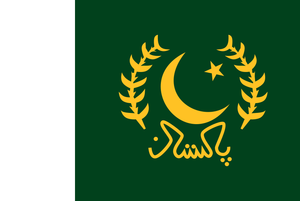President of Pakistan
(political position) | |
|---|---|
 | |
| Start | 23 March 1956 |
| Website | http://www.president.gov.pk |
| Used to shift between military dictators and civilians. Since 2008 a figurehead position. | |
The President of Pakistan is the ceremonial head of state of Pakistan and the Commander-in-Chief of Pakistan Armed Forces.[1][2] Having been a powerful institution for the most of Pakistan's history, it has since 2008 been relegated to a ceremonial function.
British Influence
There have been a total of 13 people who have held the office of President since independence in 1947. The first one was Iskander Ali Mirza, who entered office on 23 March 1956 after the post was created when Pakistan formally moved from being a Dominion, and became an Islamic Republic.
Mirza was carefully handpicked by the British as part of an effort to keep continued influence in the new country. Several other presidents have close connections to Britain and the British army, Iskander Ali Mirza (Sandhurst); Ayub Khan (Sandhurst);Yahya Khan, who was posted as the only Muslim instructor at the British Indian Army Staff College in Quetta at the time of partition of India. Most others have done parts of their education in prestigious universities in the UK.
Changing Power
From 1947 until 1956, the governor-general of Pakistan acted for the head of state: King George VI (until 1952) and Queen Elizabeth II (from 1952). With the promulgation of the first Constitution, Pakistan became an Islamic republic in 1956, and the governor-general was replaced with the presidency. The incumbent Governor-General, Iskander Mirza, became Pakistan's first president. He reportedly suspended the first Constitution in 1958, and appointed Army commander-in-chief general Ayub Khan as the first chief martial law administrator. Khan subsequently dismissed Mirza in order to become the president.
The second Constitution introduced by President Ayub Khan turned the country into a presidential republic without direct elections. Succumbing to internal and international pressure, however, Khan held a nationwide presidential election in 1965. Khan successfully campaigned against his opponent, Fatima Jinnah, for a second term, but some have alleged that elections were rigged in favour of Khan.
Controversy regarding the U-2 incident (1960), privatization (1963), and war with India (1965), fueled a fierce left-wing opposition movement led by Zulfikar Ali Bhutto of the PPP and Bengali nationalist Sheikh Mujibur Rahman who, with the support of demonstrators, aimed to further weaken the presidency. Suffering from paralysis and declining health, Ayub Khan handed over the presidency to army chief General Yahya Khan, who imposed martial law and announced that nationwide elections would be held in 1970. Eventually, general elections were held in 1970 which saw the PPP gaining a majority of seats in West Pakistan (current day Pakistan) and the Awami League gaining a majority in East Pakistan (current day Bangladesh).
After he was unable to reach a compromise between the PPP and the Awami League, President Yahya Khan invited Nurul Amin of the Pakistan Muslim League to become the prime minister, and also appointed him as the first vice president. The growing instigated violence against Pakistanis in East Pakistan forced President Yahya Khan to use force in order to maintain order there, which further escalated Bengali resistance (1970). Preemptive strikes against India led to another war in 1971, which freed East Pakistan and created Bangladesh.
Taking personal responsibility for the political isolation and devastation of Pakistan after the fall of East Pakistan, President Yahya Khan stepped down and ceded power to Zulfikar Ali Bhutto. President Bhutto created the current Constitution of Pakistan in 1973, transforming Pakistan into a parliamentary democracy, and reducing presidential powers to that of a ceremonial figurehead.
Office Holders on Wikispooks
| Name | From | To | Description |
|---|---|---|---|
| Mamnoon Hussain | 9 September 2013 | ||
| Asif Ali Zardari | 9 September 2008 | 8 September 2013 | |
| Muhammad Soomro | 18 August 2008 | 9 September 2008 | Acting |
| Pervez Musharraf | 20 June 2001 | 18 August 2008 | |
| Muhammad Zia-ul-Haq | 16 September 1978 | 17 August 1988 | Assassinated in plane crash |
| Muhammad Zia-ul-Haq | 5 July 1977 | 24 March 1985 | De facto president |